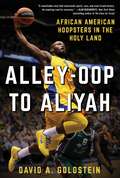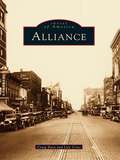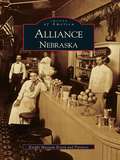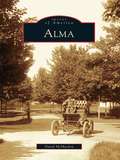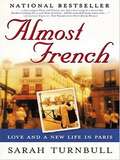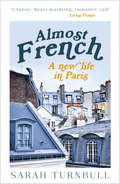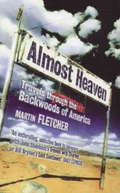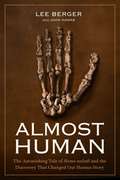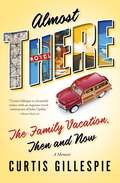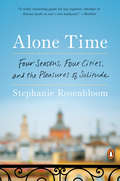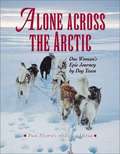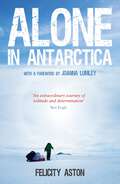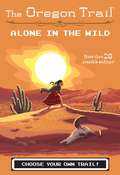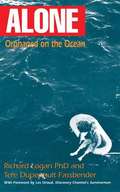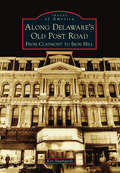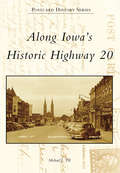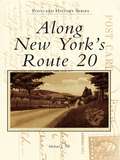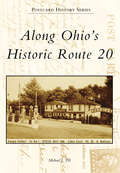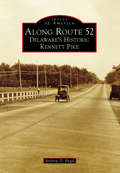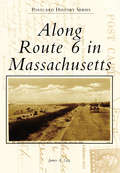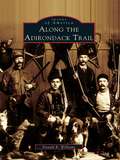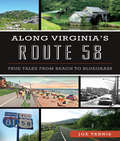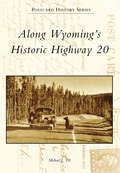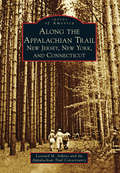- Table View
- List View
Alley-Oop to Aliyah: African American Hoopsters in the Holy Land
by David A. GoldsteinEvery season, dozens of African American basketball players pack up their sneakers to play and live in Israel. They eat Israeli food, navigate Israeli hustle and bustle, experience cultural and religious customs in the world’s only Jewish country, and voluntarily expose themselves to the omnipresent threat of violence in the volatile Middle East. Some players are both Black and Jewish by birth. Others choose to convert to Judaism while residing in Israel. Some go so far as to obtain Israeli citizenship, enlist in the Israeli Army, marry Israeli women, and stay long after their playing careers end. Alley-Oop to Aliyah: African American Hoopsters in the Holy Land, is the first book to provide an in-depth exploration and analysis of the experiences of African American basketball players in Israel from the 1970s till today. Author David A. Goldstein examines how they end up in the country in the first place, the multitude of distinctive aspects of their lives there, the challenges and difficulties they face, and the reasons some choose to return to Israel year after year. In some cases they even decide to stay in Israel permanently. Alley-Oop to Aliyah not only deals with basketball and its impact on Israel, but it delves into emotion-laden issues of race, religion, identity, and politics, primarily through the eyes of the players themselves, based on more than forty extensive first-person interviews Goldstein, a sports journalist of half-Israeli descent, conducted. Their stories and their impact on Israel are at the very heart of this revealing book that is about more than just a game.
Alliance (Images of America)
by Lyle Crist Craig BaraAccording to local history, General Robinson, a railroad official from Pittsburgh, Pennsylvania, named this Ohio town "Alliance" in 1850. Known for a short time as "The Crossing," Robinson believed that Alliance was a better name since the nation's two major railroads intersected here. The name stuck, and in 1854, the communities of Williamsport, Freedom, and Liberty incorporated as the town of Alliance. In 1889, the Village of Mount Union was annexed and Alliance became a city. Not only did therailroads help form our community, they established Alliance as a city of industry. Even though the town has remained relatively small, with approximately 23,000 citizens in 1990, industry has played a vital role in the development of Alliance. Many citizensattribute the strong leadership of the town's governing body to its industrial growth. This pictorial compilation documents the growth of the railroad and the stores and factories located along these railroad routes. Even today, the availabilityof trains and the intersection of key lines in Alliance is important to manufacturers.
Alliance, Nebraska (Images of America)
by Knight Museum Board and PartnersOnce heralded as the "Queen City of the Plains,"Alliance, Nebraska originated as a simple railroadjunction called Grand Lake. Founded on true pioneerspirit in 1887, Alliance has grown from a farm and ranchcommunity into a major retail center for Box Butte County.The Knight Museum showcases over 200 images in this newbook, depicting the history and growth of Alliance during its113-year history.Although there are many anonymous threads that makeup the social fabric of Alliance, readers will recognize themore familiar faces of the Newberry family, Dr. Frank Knight,Miss Susan Frazier, and Miss Katherine Schill. While somelandmarks are gone forever, such as the depot and the CoorsBuilding, many timeless photographs remain to guide thereader down the main street of Alliance's rich history. Fromthe vintage image of the county courthouse to the beautyof western Nebraska's largest park system, readers will get aglimpse of the pioneering spirit that is still so abundant.
Alma
by David McmackenRalph Ely, founder of Alma, selected 10 acres of old forest on the bank of the Pine River in 1853. In this central-Michigan wilderness, he built a log cabin, a log store, and two steam-powered mills--a sawmill and a gristmill. At first, his growing settlement was called Elyton, but within a few years, it was renamed Alma, memorializing a battle in the Crimean War. Alma was energized by the acquisition of millionaire lumberman and entrepreneur Ammi W. Wright, who poured his resources into the town. Wright encouraged the establishment of Alma College in 1886 and the state Masonic home for the elderly in 1911. Wright laid the foundations for Alma's great Republic Truck Company, the largest exclusive maker of trucks in the world by 1920. The discovery of several oil fields prompted the establishment of two oil refineries in Alma in the 1930s and saved the town from the doldrums of the Great Depression. By the 1950s, Alma was a key national manufacturer of house trailers and mobile homes. This photographic panorama reflects the city's economic cycles and its institutions that have given Alma an enviable stability through the years.
Almost French
by Sarah Turnbull'This isn't like me. I'm not the sort of girl who crosses continents to meet up with a man she hardly knows. Paris hadn't even been part of my travel plan . ' After backpacking her way around Europe journalist Sarah Turnbull is ready to embark on one last adventure before heading home to Sydney. A chance meeting with a charming Frenchman in Bucharest changes her travel plans forever. Acting on impulse, she agrees to visit Fr d ric in Paris for a week. Put a very French Frenchman together with a strong-willed Australian girl and the result is some spectacular - and often hilarious - cultural clashes. Language is a minefield of misunderstanding and the simple act of buying a baguette is fraught with social danger. But as she navigates the highs and lows of this strange new world, from the sophisticated caf s and haute couture fashion houses to the picture postcard French countryside, little by little Sarah falls under its spell: passionate, mysterious, infuriating, and charged with that French specialty - s duction. And it becomes her home. ALMOST FRENCH is the story of an adventurous heart, a maddening city - and love.
Almost French: A New Life in Paris
by Sarah TurnbullA delightful new twist on the travel memoir, Almost French takes readers on a tour fraught with culture clashes but rife with insight and deadpan humour - a charming true story of what happens when Sarah meets a very French Frenchman. Backpacking around Europe, twenty-something Sarah Turnbull meets Frederic and impulsively accepts his invitation to visit him for a week in Paris. Eight years later, she is still there - and married to him. The feisty Sydney journalist swaps vegemite for vichyssoise and all things French, but commits the fatal errors of bowling up to strangers at classy receptions, helping herself to champagne, laughing too loudly and (quelle horreur!) rushing out for a baguette in her 'pantalons de jogging'. But Paris' maddening, mysterious charm proves irresistible and Sarah makes spectacular progress. She finds work as a freelance journalist, learns to survive Parisian dinner parties and how to deal with grim-faced officialdom. As she navigates the highs and lows of Parisian life, covering the haute couture fashions shows and discovering the hard way the paradoxes of France today, Sarah succeeds in becoming 'almost French'.
Almost Heaven: Travels Through the Backwoods of America
by Martin FletcherAfter seven years as Washington correspondent of THE TIMES, Martin Fletcher set off to explore the great American 'boondocks' - the raw and untamed land that exists far from the famous cities and national parks. His extraordinary journey takes him to places no tourist would ever visit, to amazing communities outsiders have never heard of, to the quintessential America. He encounters snake-handlers, moonshiners, creationists, outlaws, polygamists, white supremacists and communities preparing for Armageddon. He goes bear hunting in West Virginia, fur trapping in Louisiana, diamond digging in Arkansas and gold prospecting in Nevada. From the eccentric but friendly to the frankly unhinged, the inhabitants of backwater America and their preoccupations, prejudices and traditions are brought vividly to life.'Fletcher is not only capable of excellent penmanship, but is also able to view the country and its people as both outsider and insider, and does so without being judgmental. I found his warm and subtly humorous style very appealing, and I highly recommend this book' INDEPENDENT ON SUNDAY
Almost Human: The Astonishing Tale of Homo Naledi and the Discovery That Changed Our Human Story
by John Hawks Lee BergerIt was the find of a lifetime: The bones of multiple individuals, hidden deep underground in the region of South Africa called the Cradle of Humankind. Only the slimmest expedition members could squeeze through the jagged rock channels to reach the cave and its amazing treasures. In this freewheeling tale of science and exploration, celebrated paleoanthropologists Lee Berger and John Hawks tell the story of how Berger and his team discovered rich caches of fossils representing all-new species on the human family tree. How old are these bones? How did they get so deep underground? What do they tell us about our earliest ancestors? Berger's answers transform our sense of who we are and how we got here.
Almost There: The Family Vacation, Then and Now
by Curtis GillespieWe all have memories of family vacations: the cross-country marathon drive, the camping trip, a couple lazy weeks at the lake, a helter-skelter month in Europe, four days in Disneyland. The variations may be endless, but the common denominator is that there are always stories to tell. The family vacation, with all its funny, sad, relaxing, stressful, frustrating, and exhilarating moments, shapes us, and helps us create an understanding of who we are and of those we travel with. In his humourous new book, Almost There, award-winning writer Curtis Gillespie explores the meaning of our family vacations, the memories created by them, and how we use these memories to define our relationship with our families and ourselves. Using his own history of family vacations as a backdrop, Gillespie explores how the meaning and symbolism of the family vacation has shifted throughout the decades. For years, families drove across the country or relaxed at a lakeside cottage. Now even the middle-class travel with their nannies or go on a Disney cruise … or take their nannies with them on a Disney cruise. As he sifts through memories and explores family vacation history, Gillespie ultimately discovers that not only is how we choose to vacation an expression of who we are as individual families, but that the very nature of the family vacation reflects, and sometimes even predicts, societal change. The family vacation is something we all share; the laughter, the tears, the moments, the memories. In Almost There, Curtis Gillespie reminds us how important these moments in our lives are, and how important they will continue to be.
Alone Time: Four Seasons, Four Cities, and the Pleasures of Solitude
by Stephanie RosenbloomA wise, passionate account of the pleasures of travelling soloIn our increasingly frantic daily lives, many people are genuinely fearful of the prospect of solitude, but time alone can be both rich and restorative, especially when travelling. Through on-the-ground reporting and recounting the experiences of artists, writers, and innovators who cherished solitude, Stephanie Rosenbloom considers how being alone as a traveller--and even in one's own city--is conducive to becoming acutely aware of the sensual details of the world--patterns, textures, colors, tastes, sounds--in ways that are difficult to do in the company of others.Alone Time is divided into four parts, each set in a different city, in a different season, in a single year. The destinations--Paris, Istanbul, Florence, New York--are all pedestrian-friendly, allowing travelers to slow down and appreciate casual pleasures instead of hurtling through museums and posting photos to Instagram. Each section spotlights a different theme associated with the joys and benefits of time alone and how it can enable people to enrich their lives--facilitating creativity, learning, self-reliance, as well as the ability to experiment and change. Rosenbloom incorporates insights from psychologists and sociologists who have studied solitude and happiness, and explores such topics as dining alone, learning to savor, discovering interests and passions, and finding or creating silent spaces. Her engaging and elegant prose makes Alone Time as warmly intimate an account as the details of a trip shared by a beloved friend--and will have its many readers eager to set off on their own solo adventures.
Alone across the Arctic: One Woman's Epic Journey by Dog Team
by Pam Flowers Ann DixonAlone across the Arctic tells the gripping adventure story of Pam Flowers's solo trip across the North American arctic coast with her eight sled dogs. Inspired by Knud Rasmussen's pioneer 1923-24 expedition along the same route, Pam is the first woman to traverse the arctic coast alone. Pam's astounding year-long journey over 2,500 miles of frozen wilderness exposed her to heart-stopping perils, from intense blizzards and melting pack ice to a frightening polar bear encounter. With storytelling and journal extracts, she offers powerful insights into the challenges and rewards of such an epic achievement.
Alone in Antarctica: The Classic True Story of One Woman's Solo Journey Across Antarctica
by Felicity Aston Joanne LumleyAt the age of 34, Felicity Aston became the first woman to cross Antarctica alone. Frozen into her facemask, she battled desperate weather and raced to reach the coast before the last flight out. This gripping and inspirational account shows what you can achieve when you grit your teeth and decide just to get through today in one piece.
Alone in Antarctica: The Classic True Story of One Woman's Solo Journey Across Antarctica
by Felicity Aston Joanne LumleyAt the age of 34, Felicity Aston became the first woman to cross Antarctica alone. Frozen into her facemask, she battled desperate weather and raced to reach the coast before the last flight out. This gripping and inspirational account shows what you can achieve when you grit your teeth and decide just to get through today in one piece.
Alone in the Wild (The Oregon Trail)
by Jesse WileyIn this exciting choose-your-own-trail stand-alone experience featuring 8-bit art, it's 1849 and you are at the halfway point on your journey west on the Oregon Trail. When a powerful storm separates you from your family, you must use all of your smarts to survive on your own. Along the way, you meet a twelve-year-old girl from the Shoshone Nation, who has the grit and smarts to help you both make it to Oregon Territory. Which path will get you safely across the country and reunited with your family? With twenty-two possible endings, choose wrong and you'll never live out your dreams. Choose right and blaze a trail that gets you to Oregon City! Twitter: @oregontrail Facebook: facebook.com/oregontrail/
Alone: Orphaned on the Ocean
by Richard D. Logan Tere DuperraultTere Duperrault was 11 years old when her family was murdered at sea aboard a rented sailboat off the coast of Florida. She jumped overboard just in time to escape. Surviving four days on a piece of cork in the middle of the ocean, Tere's rescue pictures graced LIFE Magazine soon after her rescue. This is the first time Tere has ever been able to tell her story fully. Oprah reunited her in September 1988 with the freighter captain who saved her but even then, she was not healed enough to reveal what it takes to survive for four days adrift alone at sea. Co-authored by renowned psychologist and survival expert Richard Logan, readers delve into the details of how a little girl survived the murder of her family; the pod of whales who guarded her; the aftermath and the recapturing of life. The ultimate inspirational tale of good winning over evil.
Along Delaware's Old Post Road: From Claymont to Iron Hill
by Ken BaumgardtAlong Delaware's Old Post Road: From Claymont to Iron Hill snakes through the Colonial towns of Claymont, Wilmington, Newport, Stanton, Christiana, and the Pencader Hundred portion of northern Delaware. This 13-mile route has different names, from Philadelphia Pike to Maryland Avenue to Old Baltimore Pike, but it is along this road that the State of Delaware has its earliest roots. The photographs of the people and places are mostly misty memories as the route grew from a narrow dirt road to a modern four-lane thoroughfare. From Cooch's Bridge at one end, where the only battle on Delaware soil was fought, to Archmere Academy at the northern end, the corridor has a largely forgotten place in history. Travelers now trace the same route once traversed by George Washington, Thomas Jefferson, and Charles Mason and Jeremiah Dixon as they rode into history.
Along Iowa's Historic Highway 20
by Michael J. TillUS Highway 20 was designated a federal highway in 1926. For the first half of the 20th century, it was the most important east-west road across northern Iowa, extending from the Mississippi to the Missouri River. The road connected 13 counties, four major metropolitan areas, and many smaller communities along its route. Fortunately, the historic two-lane road remains almost completely intact and can be driven much as travelers did in years gone by. Along Iowa's Historic Highway 20 celebrates such a trip, illustrated by more than 200 antique postcards that show the personality of the road: town and city scenes, rural vistas, rivers, bridges, and historic sites. Not to be forgotten are the tourist courts, hotels, diners, and gas stations that made travel possible.
Along New York's Route 20 (Postcard History Series)
by Michael J. TillFew roads can match Route 20's beauty, history, or contribution to New York's vitality. In 1926, Route 20 became a federal highway and evolved into New York's foremost east-west road. But unlike most early highways, it has survived almost completely intact. The story of Route 20 is told through more than 200 vintage postcards showing scenes from the Shaker communities in Columbia County to the Lake Erie Shore. The postcards show the personality of the road: main streets, the Finger Lakes, and scenic vistas. Not to be forgotten are the tourist courts, hotels, diners, and gas stations that made travel possible.
Along Ohio's Historic Route 20 (Postcard History Series)
by Michael J. TillRoute 20 was named a federal highway in 1926, and for the first half of the 20th century it was the most important east-west road across northern Ohio. Extending from the Pennsylvania border east of Conneaut to its western terminus with Indiana, it made Ohio the connecting link between Northeastern and Midwestern states. Fortunately, Route 20 has remained virtually intact and can be traveled much as people did in years past. Postcard History Series: Along Ohio's Historic Route 20 celebrates such a trip, illustrated by more than 200 vintage postcards depicting views along the way. Town and city scenes, rural vistas, and historic sites that drew early motorists to the highway are featured. Not to be forgotten are the tourist courts, hotels, diners, and gas stations that made automobile journeys possible.
Along Route 52: Delaware's Historic Kennett Pike (Images of America)
by Andrew D. EngelCreated through an act of the Delaware Legislature in 1811, the Wilmington and Kennett Turnpike would become one of the most important roads in New Castle County. Linking the city of Wilmington, Delaware, to Kennett Square, Pennsylvania, it would become crucial in the transportation of goods from a growing industrial Wilmington to Philadelphia and the eastern counties of Pennsylvania. Kennett Pike, as it would come to be known, operated as a toll road until it was purchased in 1919 by industrialist Pierre S. du Pont (1870-1954). Du Pont would work over the next year and a half to widen and modernize the highway and eliminate its tolls. When work was completed, he sold the road back to the state for just $1. Kennett Pike has continued to grow through the 20th century, with dozens of private estates gracing its borders. Villages such as Greenville and Centreville have been characterized by their country charm and local businesses, including Shields Lumber & Coal and Buckley's Tavern.
Along Route 6 in Massachusetts (Postcard History Series)
by James A. GayRoute 6 in Massachusetts runs from Provincetown to Seekonk and passes through some of the most beautiful scenery in the state. What had once been a mere footpath for Native Americans, then widened for the use of stagecoaches, Route 6 would be officially designated the “King’s Highway” in 1920. The moniker was extremely unpopular with the local residents, so much so that the governor officially changed the name to the Grand Army of the Republic Highway in 1937. Depicted from the author’s personal collection of postcards from the 1920s to the 1960s, Route 6 winds its way around tiny fishing villages, sand dunes, marshes, beaches, lighthouses, campgrounds, hotels, restaurants, and historic cities. The combination of Route 6 and the automobile would make Cape Cod a world-renowned tourist destination.
Along The Adirondack Trail
by Donald R. WilliamsNative Americans called the area Couxsaxrage, "beaver hunting ground." Professor Ebenezer Emmons named it Adirondack, after one of the native tribes. Along the Adirondack Trail traces the history and lore of the Adirondacks up the scenic roadway through the heart of New York's mountain-and-lake country. Included are tales of the Mohawk Indians and their beatified princess, Tekakwitha; the site of the mansion of Sir William Johnson, one of America's most influential citizens of the 1700s; and an important battleground of the Revolution. Rare original photographs portray each of the twenty settlements on the trail from Fonda to Malone, reflecting the lives of the guides, loggers, trappers, sportsmen, camp owners, tourists, leather workers, and health seekers who opened up the unknown county.
Along Virginia’s Route 58: True Tales From Beach to Bluegrass (History And Guide Ser.)
by Joe TennisRoute 58 stretches across all five hundred miles of Virginia, from the sandy shores of the Atlantic to the waterfalls and wild ponies of the Blue Ridge Highlands. Weird, quirky and intriguing legends and lore lie along this historic highway, including a UFO landing in South Hill, Virginia Beach's "witch duck" controversy of 1706 and Nat Turner's bloody insurrection in 1831. Country music icon Johnny Cash played his final shows at the world-famous Carter Fold. Civil War skirmishes touched towns. The "Wreck of the Old 97" happened in Danville, and haunting memories of a schoolhouse lost to a tornado remain in Rye Cove. Author Joe Tennis provides a guide to Route 58 with a trail of tales, accompanied by easy driving directions and vivid photography.
Along Wyoming's Historic Highway 20 (Postcard History)
by Michael J. TillHighway 20 was designated a federal highway in 1926, and until the arrival of the Interstate Highway System in the 1950s it was a primary route across northern Wyoming. From the Great Plains in the east to the mountains in the west, Highway 20 passed though cities and towns that retain their frontier visages and such wonders as Hell's Half Acre, the Wind River Canyon, Natural Hot Springs, Buffalo Bill Scenic Byway, and spectacular Yellowstone National Park. Fortunately, historic Highway 20 remains almost completely intact and can be driven much as travelers did in years past. Postcard History Series: Along Wyoming's Historic Highway 20 celebrates this trip, illustrated by more than 200 vintage postcards showing the personality of the road. Not to be forgotten are the tourist courts, hotels, diners, and gas stations that made automobile travel possible.
Along the Appalachian Trail: New Jersey, New York and Connecticut
by Leonard M. Adkins Appalachian Trail ConservancyCrossing through 14 states from Maine to Georgia, the Appalachian Trail enters New Jersey through the Delaware Water Gap, crosses New York's Hudson River, and rises over Connecticut's Lion's Head. The area is considered by some to be the pathway's birthplace, for in 1923, just two years after Benton MacKaye originally proposed the trail, the first few miles specifically constructed for the Appalachian Trail were built by volunteers in New York's Harriman and Bear Mountain State Parks. These photographs and the corresponding narrative present a historical perspective on what it took to create the trail, including the thousands of volunteers and the arduous tasks they performed, those who lived along the trail before and during its creation, the many people who have enjoyed the trail through the years, and the original routes that are no longer part of the present-day Appalachian Trail.
